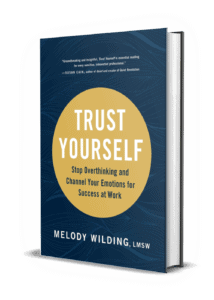Picture it…You’re in a meeting with a few colleagues and your boss, discussing a project you’re heavily involved with. Although you have thoughts to share, you’re silent. Dialogue ping-pongs between your manager and co-workers. You can’t get a word in edgewise. It’s a reoccurring obstacle. You can’t seem to get a handle on how to politely interject during a meeting.
You wait for the moment when it feels appropriate to butt in, but the moment never comes. The meeting has ended before you know it and you barely said a word. You log off feeling defeated and frustrated with yourself.
Sound familiar?
This happened to my client, Heidi, a marketing director at a sports company. Heidi was accomplished and considered a subject matter expert in analytics. Despite her expertise, Heidi frequently overthought her contributions. She placed a high expectation on herself to share value – and that perfectionism often held her back from speaking at all.
Add to that the fact that Heidi was also exceedingly courteous and kind. She never wanted to be pushy, rude, or dominate the conversation. While her intentions were good, these tendencies lead Heidi to wait too long to contribute in meetings. This not only eroded her confidence but also contributed to a lack of influence in her job. She needed to learn how to break this cycle, she needed to be able to interject during a meeting.
Heidi is what I call a Sensitive Striver – a high-achiever who is also highly sensitive. Because of their qualities, Sensitive Strivers like Heidi often have challenges interjecting and asserting themselves to make a point. You may try to build up the courage to speak, only to struggle to find a way into the conversation.
There are many reasons you may have to interject during a meeting. You may be offering a perspective, providing an update, correcting a matter, or asking for clarification. Or perhaps you are trying to push your team to stay on track. Whatever the reason, it’s essential to interject with tact.
Here are some ideas I share with Heidi that may work for you, too.
1 – Break the ice
The longer you wait to say anything in a meeting, the more your fear and hesitation will build. So make a point to contribute early on. You don’t have to be the first person to speak, but try to be the second or third. Remove perfectionism as well. What you share doesn’t have to be groundbreakingly original. You can offer a point of view or information if you have it, but piggybacking off of someone else’s comments works, too. Using your voice early will help you get comfortable expressing yourself and make it easier to break through resistance that keeps you quiet.
2 – Create a disclaimer
Set ground rules at the start of the conversation. Mention that to keep the conversation efficient and effective, you may jump in to keep the discussion on track with the team’s stated goals. This gives you air cover when you do need to interrupt, such as, “Amy, as I said at the top of the meeting, our main goal today is X, and to keep us on track, we’ll have to punt Y until next time.”
3 – Gauge timing
If you want to interject during a meeting, it is all about intuiting the best time to speak up based on your team’s norms. Generally speaking, it’s best to wait for the speaker to pause for a few seconds before you pipe up. But if you’re remote or happen to be in a faster-paced environment, err on the side of interjecting a bit sooner.
Free GUIDE
7 Strategies to Speak Up With Confidence
Don’t sit through another meeting paralyzed by fear. Get the guide leaders at Google and Facebook use to voice their opinions with confidence.
Unsubscribe at any time. Your details are protected in accordance with my Privacy Policy.
4 – Look for natural transition points
It will feel like a smoother transition for you and your audience if you interject between agenda points or topics or if you build on what a previous speaker has already shared. For example, some phrases you can use include:
- Before we move on, let me add…
- Excuse me, there’s something I need to say here…
- Do you mind if I jump in? I have an idea that relates to what you just said…
- I’m glad you brought that up. I’d like to add…
5 – Ask for permission
If you’re interrupting someone more senior than you or the meeting organizer, be deferential and ask for permission. For example:
- Am I okay to pause you for a second and add a legal perspective?
- Can I jump in quickly to share my thoughts?
- Is now a good time to bring up X?
Asking permission in this way doesn’t make you appear weak, rather it shows you’re thoughtful and considerate of the agenda.
6 – Keep it brief
When you interject during a meeting, it should be substantial but no more than a minute or two. Start by stating your purpose for interrupting (ex. “This is a key data point for our strategy…”). Be as concise as possible. After you’re finished, politely hand the conversation back to the meeting facilitator or the next speaker. For instance, “thanks for allowing me to jump in. Greg – I’ll pass it back to you now.”
7 – Raise your hand
Sometimes the audio on virtual meetings is delayed, so indicate you want to say something by gently raising your hand, as if in a “heads up” motion. Alternatively, you can type in the chat that you have something to share so the meeting leader can then call on you. Unmuting yourself is also another signal that you’d like to speak.
8 – Use the pass the baton strategy
In advance of the meeting, review the agenda and let the organizer know where you want to contribute. That way they can “pass the baton” over to you at the appropriate time. It also creates a perception that you have greater influence.
9 – Loop back
If you share an idea and it’s looked over, don’t let the opportunity pass. Someone else may share it and get credit. Instead, speak up after the next person goes to say something like, “I didn’t get feedback on XYZ, so I wanted to know – what’s your impression of what I shared?”
10 – Ask questions
Long-winded colleague? Prevent them from going on and on by asking pointed questions. For instance:
- I’m not sure how this relates to our topic, can you explain the connection?
- Thanks for sharing. If you had to summarize your approach in one sentence, what would it be?
- Although what you’re sharing is interesting, it’s not something we have space to discuss fully today. Could you share your #1 question related to our stated goal?
11 – Disagree without being disagreeable
Asserting yourself requires standing up for your beliefs and convictions, even if that means disagreeing with someone else. Reframe conflict as a healthy and necessary part of work. It’s possible to push back tactfully or constructively play contrarian, for example with phrases like:
- Let me respectfully disagree…
- I see where you’re coming from, and I’d like to share a counterpoint…
- Allow me to play devil’s advocate for a moment…
12 – Be a broken record
If you need to more forcefully reinsert yourself when a colleague is getting aggressive, you can say their name repeatedly in an even-handed tone (“John, John, John – let me jump in here”). Hearing their own name is a pattern interrupt that gets their attention.
Free GUIDE
7 Strategies to Speak Up With Confidence
Don’t sit through another meeting paralyzed by fear. Get the guide leaders at Google and Facebook use to voice their opinions with confidence.
Unsubscribe at any time. Your details are protected in accordance with my Privacy Policy.









